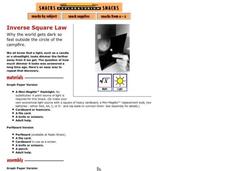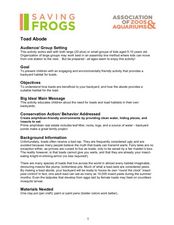University of Washington
Using Modeling to Demonstrate Self-Assembly in Nanotechnology
Do polar opposites attract? After an introduction on the polarity of molecules, pupils are asked to design a self-assembling model using materials with different polarity. The challenge should motivate learners to develop a workable...
K20 LEARN
What's My Purpose In This Life? Intro To Cell Theory/Organelles
Why are we here? Well, if you happen to be a Golgi body, the answer is simple! Young biologists embark upon a journey through the tiny world of cellular organelles with an engaging lesson from the K20 Center. The activities open with an...
Curated OER
Rate Determining Step and Catalyst Activity
Students work in groups to stuff as many envelopes as they can in 3-5 minutes. They use an assembly line method. Envelope stuffing is compared to a chemical reactions. The idea of catalyst is considered, and students determine a way to...
Lunar and Planetary Institute
Moon Flip Book
Watch an entire month flash before your eyes with this fun phases-of-the-moon flip book activity.
DiscoverE
Harmless Holder
Here's a lesson plan that's not for the birds! Scholars design and build packaging for soda cans that is environmentally friendly. These packages must be durable, easy to carry, and have no environmental impact.
Exploratorium
Blind Spot
A small card with a dot and an X is held at arm's length and used to show youngsters where their blind spot is. This illuminating little activity is a compact addition to your lesson on the structure of the eye as it explains the part of...
University of Texas
Matter and the Periodic Table Chemical Families and Periodic Trends
Is assembling the periodic table as simple as Tetris? Scholars arrange colored cards into a logical order and then make connections to the arrangement of the periodic table. Hands-on activities include adding trend arrows and analyzing...
Discovery Education
Cool It!
Adjust the melting time of ice without varying the temperature! Learners experiment with different materials to decide how the materials affect the rate an ice cube melts. They then connect their findings to the conductivity of each...
Curated OER
Globe Foldable
Maybe the world wasn't built in a day but kids can certainly assemble a globe in one class period using the images provided by these templates. Cut, fold, piece, glue, and voila!
Exploratorium
Inverse Square Law
The inverse square law is revealed when your class participates in this activity. They move a graph paper or perfboard square back and forth in a square of light to see how the intensity changes. You will definitely want to add this...
Exploratorium
Radioactive Decay Model
Toss 100 pennies (or poker chips or any other two-different-sided objects) and remove all of those displaying tails. Line them up and repeat. The lines of pennies collected get smaller each time, successfully representing half-life.
Exploratorium
Magnetic Shielding
Elementary magnetologists investigate magnetic shields using a variety of materials in a "shielding sandwich." While the activity isn't novel, it is engaging, and this particular resource includes a brief explanation of the phenomena...
Exploratorium
Resonator
Construct a demonstration apparatus for your lesson on resonance. Instructions are provided here to assemble dowels and balls into swinging objects that have different frequencies. It is a neat visual to include during your lecture if...
Exploratorium
Seeing Your Retina
Using a dimmed flashlight, life science learners can see the network of blood vessels that line the back of their eye. Darken the room and let them try this activity as part of your unit on the eyeball. Also consider some of the other...
Curated OER
Benham's Disk
Seeing is believing! Or is it? With this simple experiment, young scientists can explore the concept of visual perception. Attach Benham's disk to a rotating appliance such as a hand drill; As it spins, the black lines appear to be...
Curated OER
Digestive System, a Kinesthetic Lesson
Students actively act out an aspect of the digestive tract on two parallel strips of tape on the floor 3-4 feet apart and width of classroom which represent the digestive tract.
Curated OER
Earthquakes
Students inspect the causes and effects of earthquakes and examine how seismic waves travel. In this earthquake lesson, students determine where earthquakes happen and why, before determining how to build an earthquake resistant...
Curated OER
Toad Adobe
Students explore the importance of toads and the need for toad habitats in the environment. In this animal habitats lesson, students create an adobe habitat for toads by using a clay pot. Students paint their pots and place them in their...
Curated OER
Here It Comes, There It Goes!
Learners use an ordinary toy to reveal the Doppler effect. The connection is also made to moving cars, and to the shifting of the lines in the absorption or emission spectrum when the distance between a star and Earth is increasing or...
Exploratorium
Corner Reflector
If you set up a triad of mirrors into a corner figuration, they act as a kaleidoscope, bouncing light waves back and forth indefinitely, changing the light that your eyes perceive. Although the materials required are very specific and...
Exploratorium
Stripped Down Motor
Mostly for teacher's use, here are instructions for making a traditional electromagnetic motor and a detailed explanation of how it works.
Curated OER
Balloon Staging
Students explore rocketry using balloon rockets. They demonstrate how rockets can achieve greater altitudes by using the technology of staging. By using two inflated balloons that slide along a fishing line, they simulate a multistage...
Curated OER
Strange Attractor
Students explore magnetism. In this magnet lesson plan, students assemble a magnet pendulum. Students observe the pendulum noting the location of the magnetic poles as they construct the pendulum so that the free-swinging magnet comes as...
Curated OER
Sun-Earth Day Flip Books
Students assemble flip books. In this Earth science lesson, students read about different solar occurrences and create flip books. This teacher resource has links to create six different flip books.

























